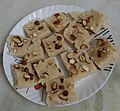Preparation
To prepare barfi, khoa (milk solids) is mixed with granulated sugar and cooked, until it thickens to a fudge-like consistency. It is then spread onto a greased plate to cool. After cooling, it is cut into squares, diamonds, or circles. It can also be formed into balls, layered, or rolled into multicolored slices. When served at special occasions, it is often decorated with vark (edible silver foil). It can also be decorated with coconut, ground nuts, or powdered milk. [1] [2] [3]
Varieties
Fruit, nuts, legumes, spices, and other flavorings may be added to the khoa-sugar mixture and yield different varieties of barfi. Commonly added fruits include guava and melon seeds. Typical nuts added include almonds, cashews, coconut, and pistachios. Mung beans are sometimes added and yield moong dal barfi. Common flavorings and spices include cardamom, kewra (fragrant screwpine), orange, mango, saffron, rosewater, and vanilla. Food colorings may also be added. [1] [2] [3]
This page is based on this
Wikipedia article Text is available under the
CC BY-SA 4.0 license; additional terms may apply.
Images, videos and audio are available under their respective licenses.








